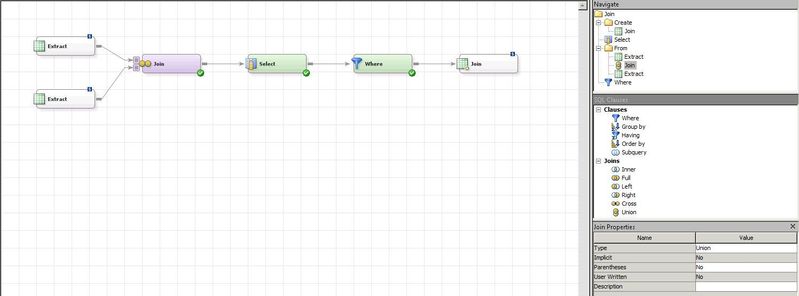- Home
- /
- Solutions
- /
- Data Management
- /
- Re: DI Studio - UNION
- RSS Feed
- Mark Topic as New
- Mark Topic as Read
- Float this Topic for Current User
- Bookmark
- Subscribe
- Mute
- Printer Friendly Page
- Mark as New
- Bookmark
- Subscribe
- Mute
- RSS Feed
- Permalink
- Report Inappropriate Content
Hi,
I have a couple of problems I need some help with:
I've two tables with identical in columns that I want to UNION together - I'm using the SQL JOIN transformation, however I'm stumped on the Mappings tab. It appears you can only map one of the sources to the target, thus ignoring that it is a UNION.
I am also having issues with a CASE statement in the Target table - the CASE wizard allows you to select a column in the target table, however this errors when running. The error states an ambiguity as the same column name is in the two source tables even though I choose the target as the source.
I'm using DI Studio 4.9
TIA,
Gordon
Accepted Solutions
- Mark as New
- Bookmark
- Subscribe
- Mute
- RSS Feed
- Permalink
- Report Inappropriate Content
Here is some documentation.
The union in the join transformation performs a Union Join: http://support.sas.com/documentation/cdl/en/sqlproc/63043/HTML/default/viewer.htm#p1bk7i6jqseje7n1li...
The union in the Set Operators transformation performs a “stacking” of tables and is probably what you are looking for: http://support.sas.com/documentation/cdl/en/sqlproc/63043/HTML/default/viewer.htm#n0vo2lglyrnexwn14e...
- Mark as New
- Bookmark
- Subscribe
- Mute
- RSS Feed
- Permalink
- Report Inappropriate Content
May I start by suggesting a look at SQL and what that means:
https://www.w3schools.com/sql/
As your use of UNION and JOIN makes no sense. They are two very different means of putting data together. Union is the process of putting data underneath another dataset, a join means to merge the data together by means of identifying variables.
With this: "The error states an ambiguity as the same column name is in the two source tables even though I choose the target as the source." - what this means is that the variable appears in both tables, and the compiler cannot decide which to take. I don't know DI and its UI, but in SQL you would assign an alias to each table and then utilse the alias to indicate to the compiler which to take:
select case when A.ID=1 then 1 else 2 end as RESULT from MYTABLE A
The A after the dataset here is the alias.
- Mark as New
- Bookmark
- Subscribe
- Mute
- RSS Feed
- Permalink
- Report Inappropriate Content
I'm familiar with how to do it in SQL - in fact it's what I'm rebuilding in DI (for data lineage purposes).
UNION is under the SQL "Join" transformations in DI Studio
The SELECT node above is where columns are mapped, obviously in a UNION we have both sources populating a single column in the target table, which DI appears not to allow.
- Mark as New
- Bookmark
- Subscribe
- Mute
- RSS Feed
- Permalink
- Report Inappropriate Content
The SQL Union is available in the "Set Operators" transformation which is in the "SQL" group on the Transformations tab.
- Mark as New
- Bookmark
- Subscribe
- Mute
- RSS Feed
- Permalink
- Report Inappropriate Content
Here is some documentation.
The union in the join transformation performs a Union Join: http://support.sas.com/documentation/cdl/en/sqlproc/63043/HTML/default/viewer.htm#p1bk7i6jqseje7n1li...
The union in the Set Operators transformation performs a “stacking” of tables and is probably what you are looking for: http://support.sas.com/documentation/cdl/en/sqlproc/63043/HTML/default/viewer.htm#n0vo2lglyrnexwn14e...
April 27 – 30 | Gaylord Texan | Grapevine, Texas
Registration is open
Walk in ready to learn. Walk out ready to deliver. This is the data and AI conference you can't afford to miss.
Register now and save with the early bird rate—just $795!
Need to connect to databases in SAS Viya? SAS’ David Ghan shows you two methods – via SAS/ACCESS LIBNAME and SAS Data Connector SASLIBS – in this video.
Find more tutorials on the SAS Users YouTube channel.


